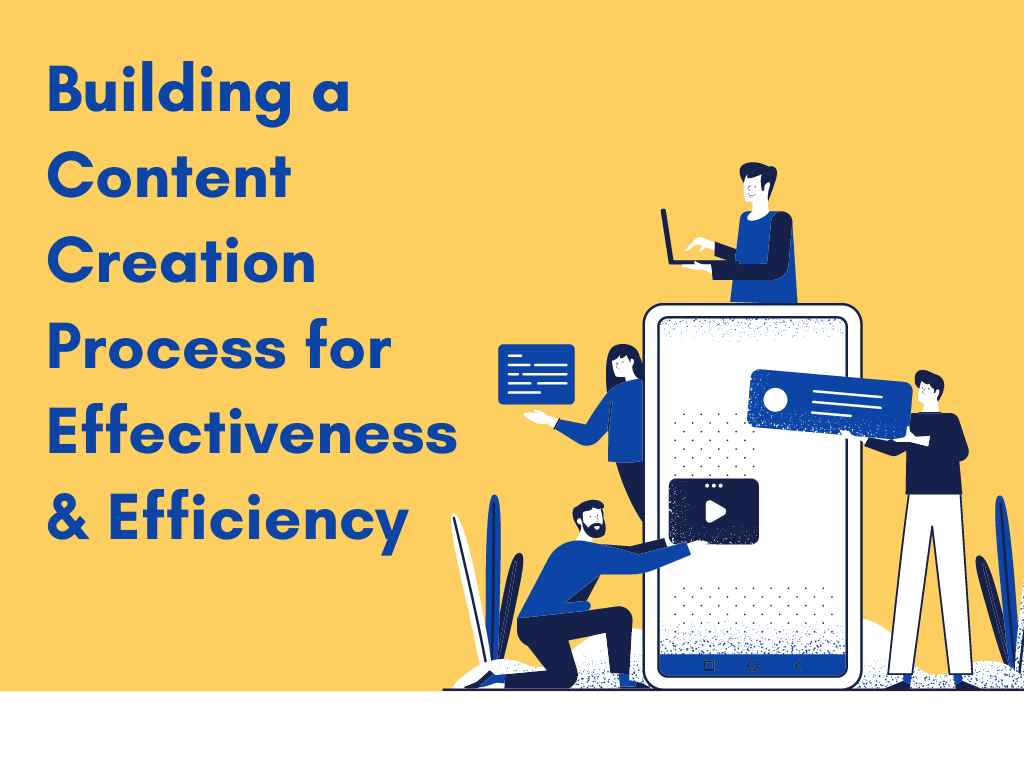What is content creation?
Content creation refers to the process of content planning, development, optimization and publishing. The content creation process can have a number of steps depending on the size and complexity of the content development operations. Content creation purposes can vary greatly too – for example – content marketing, internal company communications, sales copy development, email marketing etc.
Why do you need a content creation process?
There are numerous benefits of having a well-defined and streamlined content creation process.
Benefits of an efficient content creation process:
- Brings consistency in your content workflow – from content production and publication
- Ensures that content creation delivers real, measurable results
- Makes content creation cost-effective
- Saves resources and time
- Gives content production and marketing teams a clear action plan
- Streamlines the content workflow and assists in content collaboration
- Helps engage your audience
- Gives a competitive advantage
Content creation is a painstaking task with all the planning, research, and ideation that goes into it. An efficient content creation process can ensure consistent quality of content and frequency of publishing.
Content creation teams face a number of challenges from building a robust content strategy, constantly rising quality standards to limitations in the budget. In such a turbulent environment, a well-thought-out content creation process can be a savior. Not only does it improve the quality of content, but also improves the workflow and ensures that workload is judiciously distributed. The consistency it brings to your content enhances your brand image as well.
TL;DR Here’s a quick summary video of this article.
How to build a good content creation process?
If you are struggling to keep up with the demands of quality and quantity of content you need, it could be because your existing process isn’t adding much value to it, or worse, you probably don’t have a content creation process at all.
In such a case, you’re missing out and it’s high time you built a solid content process. To help you with it, here’s a list of the objectives for developing a good content creation process.
- Have ‘SMART’ content goals – ‘Specific, Measurable, Attainable, Relevant and Time-bound’
- Build a reliable and solid team with experts from different fields – writers, editors, videographers, graphic designers, SEO experts, marketing experts, etc.
- Develop an audience persona – know exactly who you’re creating content for
- Plan ahead – create a content calendar to keep track of ideas, progress, and deadlines
- Set time aside for research including keyword research, trending topics, industry news, competitors’ content
- Build an effective content idea generation process
- Publish the content when it is assured to be error-free and optimized for search if creating web content
- Optimize and promote old content – update old posts, re-optimize, repurpose and re-promote evergreen content
Keys Elements of a Good Content Creation Process
Irrespective of the kind of content you’re creating, a content creation process should ideally have these key elements.
- Defining the content creation goals
- Content planning
- Implementing a content creation process
- Content promotion
- Content audit and maintenance

TLDR: We have detailed each of the above elements in this post with some great insights and tips. However, if you want a quick overview of what these elements involve, the content creation process infographic below will do the job.
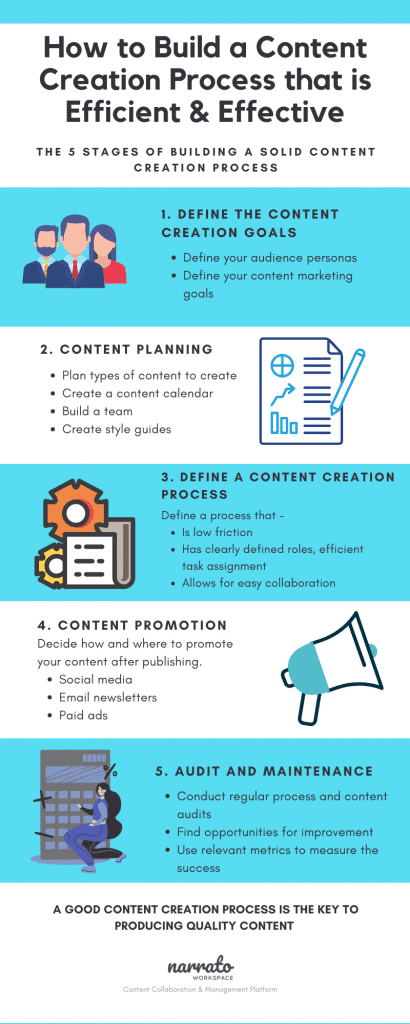
1. Defining the content creation goals
When defining your content creation goals, two things are key – understanding your audience and defining the objectives of your content.
Define audience personas
When you create content, you must know who you’re creating it for. That will decide what kind of content you need to produce in order to grab their attention. Good content is not just something that you feel strongly about, or enjoy creating. It comes from the understanding of what your audience wants to see.
So, research and find out who your target audience is, what are their pain points or interests, which channels do they mostly engage on, which of your competitors’ content do they share most, and so on. These insights will help in the decision-making process from hereon.
Define the content goals (for yourself or your clients)
When you know who your audience is, you will know what you want to achieve with them through the content. Do you want your content to generate more leads or gain? Do you want your audience to subscribe to your blog? Do you want to increase your conversion rates? Or do you want to drive more traffic to your website?
There can be different goals for the content you’re creating. Defining these goals at the very beginning gives a direction to your content creation team. Your content team will know what they’re working towards and that makes the job a lot easier. Having your goals set also makes it easier to measure your content’s success after it is published. If you are a content agency, you would want to similarly define the goals that your clients want to achieve with the content you’re creating for them.
2. Content Planning
The next stage in the content creation process is the planning stage. This is where you start mapping out the content production process.
Create a content calendar
The first step of planning involves creating a content calendar. The content calendar must define three things in general
- How much content you plan to produce during a given time
- How often you plan to publish new posts
- What kind of content you want to produce (blog posts, videos, podcasts, infographics, email, etc.)
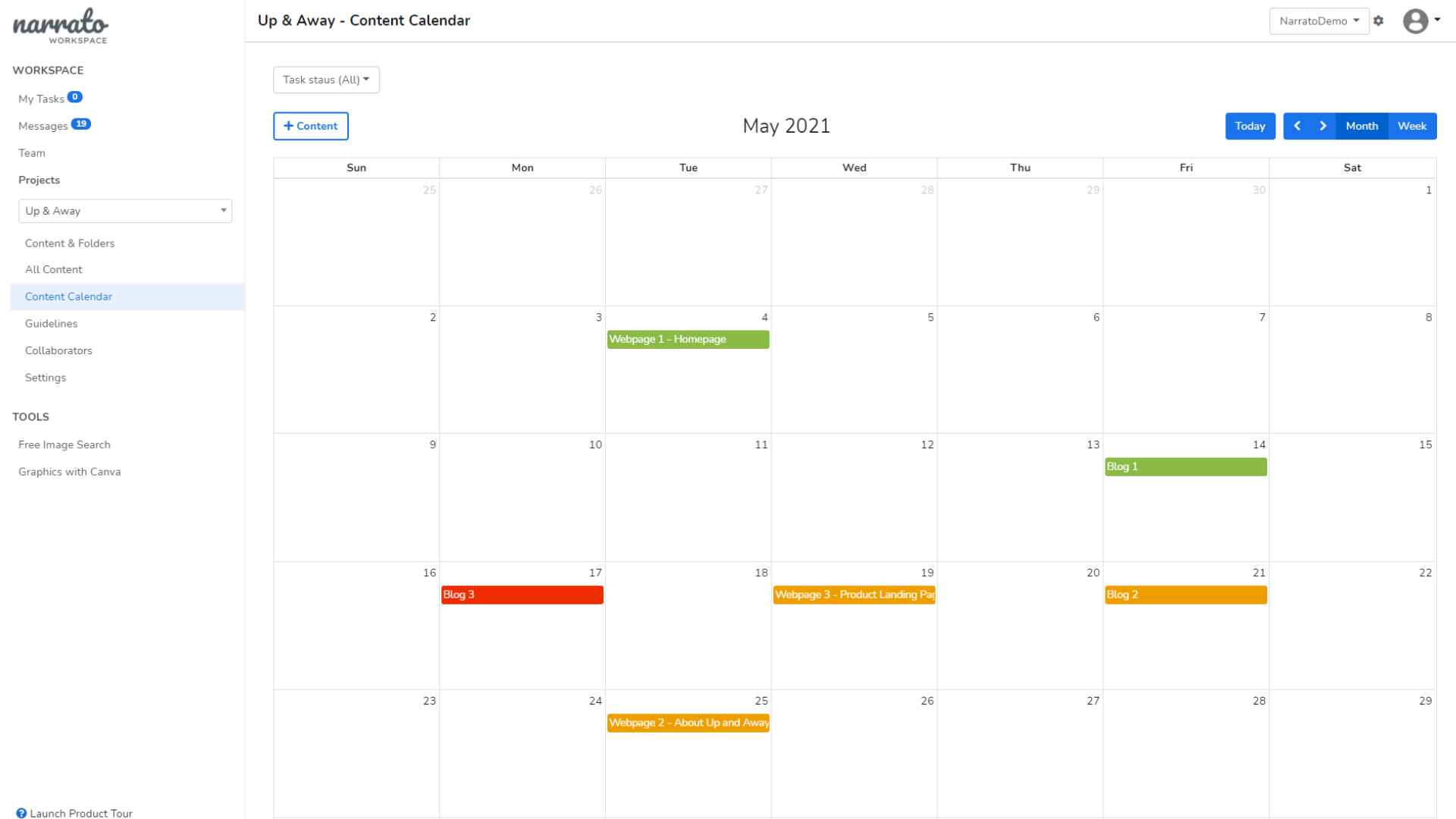
Source: Narrato Workspace
The content calendar can set the timelines for the projects, save topic ideas for new posts, display the status of an ongoing project, and so on. In other words, it should be a visual representation of the workflow that everyone on the team can access to keep track of the progress of projects. The content calendar must be regularly updated, especially when there is any new development.
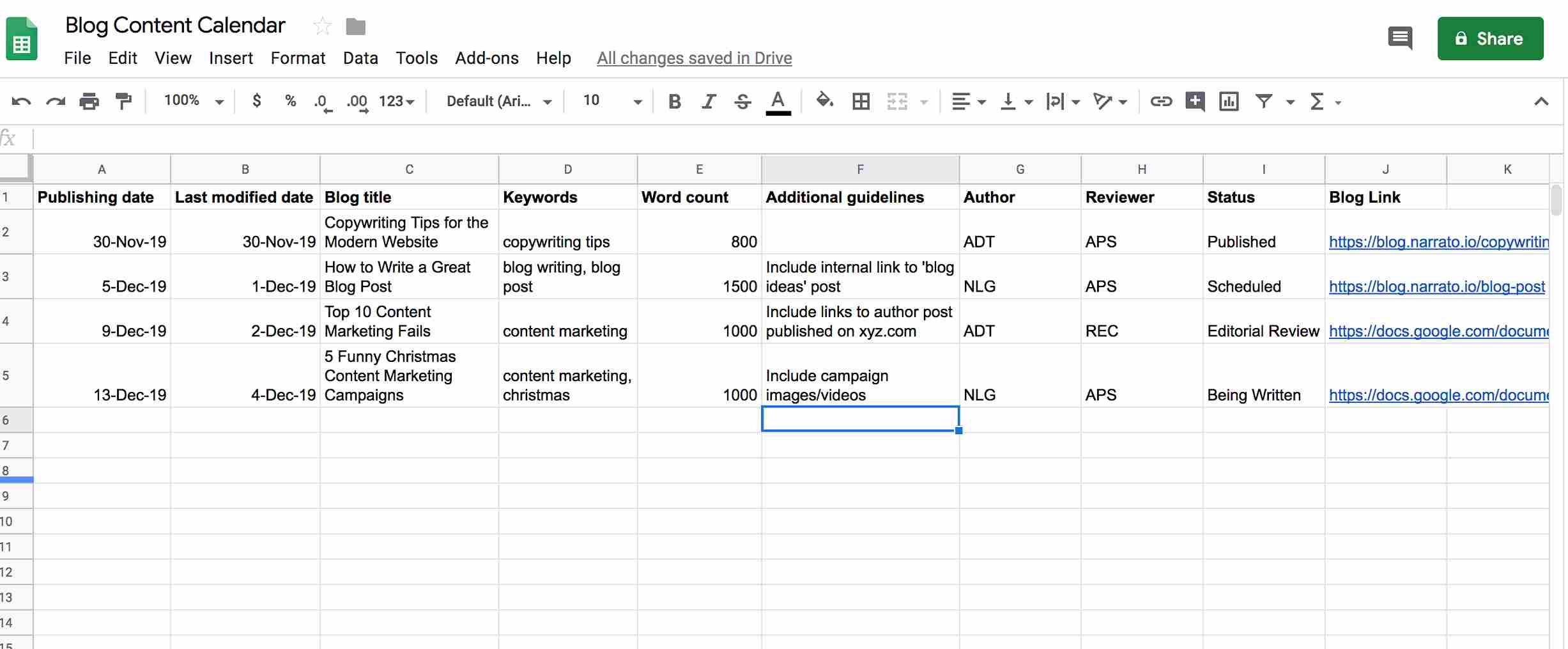
Above’s another example of a content calendar created using Google Sheets .
Build your content creation team
Your content creation team would largely depend on the kind of content you are creating.
If it is written content (which is most of the content on the web!), skilled writers and editors would be your foremost requirement. Depending on your content needs and goals, from time to time you may also need assistance from subject matter experts, SEO experts, graphic designers, web developers and some other specialists. For video content, besides content writers, you would need good videographers, animators, graphic designers, etc.
Depending on the size of your content operations, apart from the core production team, you may also need content project managers, marketing specialists, and other relevant people to make sure the team has all the required capabilities for content creation.
There are several options when it comes to hiring a content team. You can choose to hire in-house content creators or outsource your work. When hiring content writers you can choose between –
- Freelance writers
- Freelance content platforms
- Content writing agencies
- In-house writers
Each of these options has its pros and cons. Unless you need a steady stream of content on a daily basis, hiring a full-time in-house writer is not a very economical option, particularly for small businesses. Freelance writers can be a more viable choice, but finding skilled and experienced freelance writers may prove to be a challenge.
In such a case, content ordering platforms like Narrato Marketplace help you find a middle ground. With Narrato Marketplace, you can order content and a smart algorithm matches your job with the most suitable writers. The content writers on the platform are highly skilled, so you can rest assured that quality content will be delivered. You can also request as many revisions as you like, until you are satisfied with the outcome.
Create content style guides
A content style guide sets the standards for the content that your team produces, including the tone, voice, vocabulary usage, structure, and more. The content style guide should be aligned with your brand image and your core values.
A good content style guide should clearly define the following:
- Length of content
- Formatting standards (headers, footers, fonts, spacing, etc.)
- Tone
- Voice
- SEO best practices and keyword optimization (for web content)
- Type of multimedia content to include (images, graphics, videos, etc.)
- Content objectives and purpose
The style guide gives the content creators a clear idea of what you expect from them. It also helps maintain quality consistency of the content. It is important for the content to reflect the brand values and the content style guide helps achieve that. You can have separate style guides for the different kinds of content that you plan to create.
Generate topics and content ideas
Finding topics and content ideas may sound like a trivial task, but it’s definitely not that simple. The topic of your content plays a major role in deciding whether it will be able to draw the audience in. So, you can’t just pick any topic that interests you. You will have to do a considerable amount of research for finding great topic ideas.
When looking for topics for your content, it is important to ensure that the ideas are relevant to your niche as well as aligned to your content goals. For instance, if your content goal is to encourage the audience to download an ebook, the topic of your content should be relevant to the subject matter of the ebook showing your authority on the subject. The topics you choose should help you meet your content goals.
There are some tried and tested ways that really help generate engaging new topics. Here are some ways to generate great content topics:
- Find out what is trending in your niche
- Observe what people are talking about on social media
- Find out what your target audience searches for in your niche
- Conduct keyword research to find out which keywords are searched more
- Use topic generator tools to get fresh topic ideas around certain keywords
For web content, plan for SEO
SEO content planning is essential if you want your content to appear in search. So, before you start creating your content it is important to plan how to optimize your content for search.
Here are some quick tips that might help:
- Conduct keyword search to find out which keywords the content can rank for
- Use keywords strategically and naturally within the content
- Format and structure your content well making it easy to crawl for search engines
- Optimize the length of your web content
- Use header tags appropriately
- Include strong and high-quality external links
- Use internal linking wherever possible
- Optimize your images
- Optimize content for mobile devices
- Add metadata (title tags, meta descriptions)
- Create topic clusters
There are more tips and tricks that can help improve your content’s performance in search. It would be wise to do some research on SEO best practices before you set out to create content.
3. Implementing a Content Creation Process
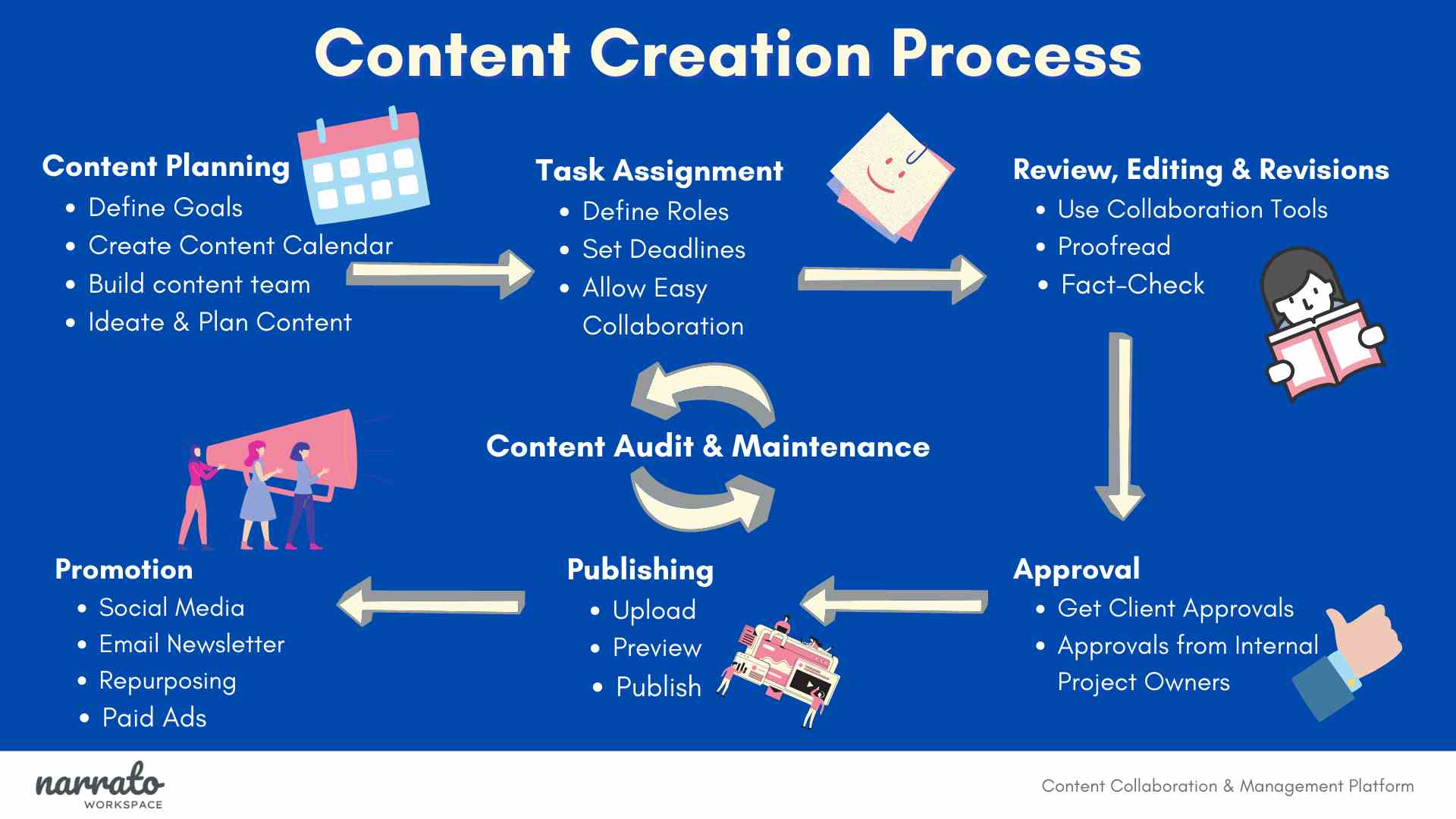
When you are setting up your content creation process and defining a streamlined content workflow, there are a few objectives to keep in mind. The process should be:
- Low friction with no bottlenecks to ensure a smooth content workflow
- Clearly defined roles and responsibilities within the team
- Efficient communication where notifications are quick and there is no communication backlog
- Easy content collaboration so that people from different areas can work together and share content easily
- An efficient task assignment, review, and publishing process to ensure that work distribution is uniform and content quality is maintained

Achieving all of this without some software or automation will be quite challenging. A content planning software like Narrato Workspace, can come in really handy here. With Narrato Workspace, you can manage your entire content workflow on a single platform.
Content collaboration on Narrato Workspace is seamless, as all your content creators, editors, and other stakeholders can work together on a single platform. You can assign content, conveniently, manage and share content guidelines, monitor the content workflow and even get the required approvals before publishing the content. It also offers several client management features, and can come in handy for content and marketing agencies to manage their client project delivery and feedback.
The platform boasts of an advanced collaborative content editor, which allows in-line comments and discussions on content, offers a grammar checker tool, readability and quality suggestions for your content, plagiarism check, keyword optimization and more. Tools like free image search and Canva integration are a bonus.

Document the content development process
Documenting the content creation process helps bring everyone on the same page and gives your team a direction to follow.
Typical content creation process steps are:
1. Periodic content planning
Set aside some time every week or every month for content planning. A team meeting can be held to discuss future projects and ideas. You can brainstorm for ideas, note down any good topic ideas, set timelines and content creation guidelines during these periodic content planning meetings. Anything that is finalized during these meetings should be immediately added to the content calendar so everyone can keep track. This helps you to be prepared for upcoming content well in advance.
2. Task assignment to the content team
A central content coordinator or content project manager is generally required to manage day to day task assignments and monitor progress. S/he needs to see that the deadlines are adhered to and there are no bottlenecks in the content production process. Reflecting deadlines on the content calendar is useful and reminders can be sent to the task owners periodically if needed.
3. Editing, review, and revisions
Editing is just as important as the content writing process. A piece of content requires more than one pair of eyes to ensure that no mistakes can sneak in. Use content collaboration tools so that editors and writers can work on the same platform and communication becomes easier. Editors should be able to add comments and suggestions on the work and content should be easily visible and shareable.
Make proofreading a mandatory part of the system to detect mistakes on time. Fact-check to ensure that all the information provided is validated. Make sure all the links included are functional. The basic idea here is to catch any errors before the content goes for publishing.
4. Approvals
For a content agency, it is absolutely essential to get the content approved by clients before they go ahead and publish. It is important that the content meets the client’s expectations and requirements. For in-house content teams as well, approval from the internal project owners is necessary before publishing. So, make sure not to skip this step.
5. Publishing
If the content is for your own website, then after approval you can simply upload, preview, and publish the final version. Make sure to stick to your content calendar as much as possible. Consistency in releasing content is important for your brand image. In the case of client projects, the publishing may be done by the content agency or the clients themselves, depending on the terms of service.
6. Content promotion
Once your content is published, you will want more people to know about it. Content promotion on the right channels can help you reach your target audience. How to choose the right channels for promotion is discussed in detail in the next section.
7. Content audit and maintenance
Ongoing content management is just as important as creating new content. It is critical to measure the success of your content to determine whether the content creation process is effective or needs improvement. That is where content audit and maintenance plays a crucial role. The details of content audit and process audit are discussed in the last section of this article.
4. Content Promotion
Once the content is published, it needs to be promoted so it can reach enough people in your target market. There are several ways of promoting your content. Here are a few tips that can help.
Choose the right promotion channels
To ensure that your content finds the right audience, it is important to know which channels your target audience is on. You can do some research and find out where your target audience spends more time online or on which channels do they engage. Choose those channels for marketing that will give you maximum reach. Some of the primary channels to consider are:
- Social media
- Repurposing content
- Paid promotion
1. Social media
Use social media channels to promote your content. There are numerous ways you can use social media to your advantage in this regard. Add Click-to-tweet buttons to your content for sharing on Twitter. Add social sharing buttons to your blog or channel so people can directly share your posts to their social media accounts.
You can also promote your content on relevant pages and forums on social media that are linked to your niche. Comment on some relevant discussions in these forums and share the link to your content. Or post some interesting trivia from your content and urge people to go to your page to learn more about it.
Using trending hashtags along with your social posts can help your posts be found. Since social media is one of the best places to connect with more people, using these little tips and tricks can help you reach a very wide audience.
2. Email (newsletters etc)
Having an email list for promoting your latest content is important. According to a survey by Content Marketing Institute, 87% of B2B marketers consider email as the primary channel for organically distributing their content.
Every time you publish new content, you can send out an email notifying your subscribers. Your email list should consist of both existing and potential followers. Add opt-in forms to your landing pages so that interested people can subscribe to your emails. Or collect email addresses when someone wants to download your resources. There are many innovative ways of growing your email list.
3. Repurposing content to increase reach
Repurposing your older content can also be a good way to promote your new posts. Turning your old blog posts into an infographic or combining a few of your shorter pieces into one long authoritative post can be really useful. You can link out to your new post from the repurposed ones on appropriate anchor text. You can also link to the repurposed content from the new posts. By doing this, you are publicizing both posts, getting more backlinks, and reaching out to a wider audience.
4. Paid Promotion
Paid ads can really boost your content by helping it get noticed. In the initial days of your content creation and marketing efforts, paid ads may seem unaffordable or feel like a huge investment that you are not ready for. But you don’t really have to spend a lot initially. Facebook ads, for instance, can start as low as $5 a day. The return on investment, however, can be considerable.

Source: Neil Patel
Paid ads can help you reach people who haven’t heard of your brand yet. Creating targeted ads can help you garner the attention of the right people. Put some thought into what you want your ad to say, how you want the ad to look like and where you want it to be placed, and you could create a great campaign at very little cost.
5. Audit and Maintenance
Lastly, it is important to measure the success of your content creation process and track your content’s performance. For this ongoing content management, you need to conduct audits of your content and process on a regular basis. Measure the success using some relevant metrics and make improvements wherever possible to ensure that your content continues to deliver the desired results.
Conduct regular audits to see how efficiently the process is working
Audits can be divided into two categories here – Process audit and Content audit.
Process audit refers to an audit of the content creation process as well as your content marketing process. This involves:
- Reviewing how your content creation process is adding value to the content
- Identifying any gaps in the process that may be delaying or affecting the quality of work
- Identifying weak links in the process in terms of skills or resources
The content marketing process audit will similarly review how the marketing efforts are paying off, whether the channels chosen are giving the content enough exposure, are the paid ads giving a good ROI, and so on.
Content audit on the other hand will measure how your content is performing online. It will check how your content ranks against competitors, identify opportunities for improvement in the existing content, check for SEO and broken links in the content.
This audit should give insights on which content pieces are performing best and which pieces are no longer relevant or are not bringing any results. It can help identify opportunities for improving search rankings, understanding audience preferences, and eliminating non-performing content.
Find old, evergreen content worth repurposing
Audit and maintenance also give you the opportunity to review your old posts and find content that is worth repurposing. Every content creator or marketer has some evergreen content that can be valuable to the audience and remains relevant irrespective of when it was created. Such content deserves to reach more people and can drive traffic to your site.
You should use the most valuable and authoritative pieces you have created and turn them into fresh content in a different form. You can create videos, podcasts, ebooks, or infographics from an old blog post. Or you can turn an old video tutorial into a written how-to guide. Experiment with different formats and use your creativity to repurpose old content, making them more engaging.
Use relevant metrics to measure the success of content
It is important to choose the right metrics for measuring success if you want to see the real picture. The best way to ensure that your measurement metrics or key performance indicators are meaningful is to keep your content goals in view. The purpose of the metrics is to tell you whether the content has achieved the goals set for it.
If your goal is to drive traffic to your website, the amount of traffic a post drives should be a useful metric. If your goal is to get your audience to download your ebook, the number of downloads you have got in a month is the metric you must track. Similarly, other relevant metrics could include the number of social shares, the amount of time a visitor spends on your blog or your video, the number of email subscribers you get in a month, and so on. Only when your metrics are meaningful, will you be able to judge whether the content and the content creation process are successful.
Summing up
Your content creation process lays the foundation for top-notch marketing and communication. It is important to invest effort and resources in having a well-thought-out process and following it through.
Constant monitoring and health check of the content development process is equally important. The job does not just end at creating a successful content process. You should strive to make it better over time. A good content creation process can improve your content by leaps and bounds, bring clarity and direction to your efforts and increase the productivity of your team.


